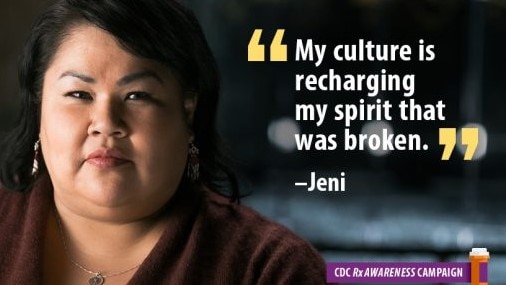Key points
- CDC is committed to addressing drug overdose in tribal communities.
- CDC works with tribal communities to strengthen the quality, accuracy, and timeliness of drug overdose surveillance data.
- CDC supports strategic planning to address opioid overdose prevention in tribal communities, so that strategies complement community strengths.
Why it's important
CDC is committed to addressing drug overdose in tribal communities. Tribal communities have many community assets found in Indigenous Knowledge that help protect against overdose.
Yet, overdose still disproportionately affects American Indian and/or Alaska Native people:
- Overdose death rates increased 20% for non-Hispanic American Indian and/or Alaska Native people from 2020 to 2021.1
- In both 2020 and 2021, rates were highest for non-Hispanic American Indian and/or Alaska Native people (42.5 per 100,000 and 56.6, respectively).1
- Death rates for overdoses involving psychostimulants were generally higher among non-Hispanic American Indian and/or Alaska Native people than other racial and ethnic groups from 2004-2019.2
The disproportionate experience of overdose and increases in overdose death rates in American Indian and/or Alaska Native persons may partly be due to health inequities, like unequal access to substance use treatment and treatment biases.
Tribal overdose surveillance and prevention efforts
Funding for Tribes, Tribal Epidemiology Centers, and tribal serving organizations:
In fiscal year 2022, CDC provided $13 million in supplemental funds to Tribes, Tribal Epidemiology Centers (TECs), and tribal serving organizations. CDC works with tribal communities to strengthen the quality, accuracy, and timeliness of drug overdose surveillance data and supports regional strategic planning to address opioid overdose prevention in tribal communities, so that strategies complement community strengths. In fiscal year 2023, CDC increased its investment to $17 million in supplemental funds to continue partnering with tribal communities in overdose prevention efforts.
Tribal overdose prevention and harm reduction efforts are also embedded in these programs and projects:
- Advancing Prescription Drug Monitoring Programs (PDMPs) and Electronic Health Records (EHR) Integration Project: The Utah Navajo Health System served as a pilot site to extend health information technology solutions to tribal systems. Advancing, improving, and scaling health IT solutions such as integrating PDMP data into EHRs, pharmacy dispensing software (PDS) systems, and health information exchanges (HIEs) are necessary to address the overdose crisis.
- Overdose Data to Action (OD2A): OD2A supports 90 jurisdictions, including state, territorial, county, and city health departments, in collecting high quality, comprehensive, and timely data on nonfatal and fatal overdoses and in using those data to inform prevention and response efforts.
- Drug Free Communities: The Drug-Free Communities (DFC) Support Program is the nation's leading effort to mobilize communities to prevent and reduce substance use among youth. There are more than 750 DFC coalitions committed to implementing local solutions that will build safe, healthy, and drug-free communities. Approximately 10% of DFC coalitions work with Tribes, Tribal organizations, or tribal serving organizations.
- Rx Awareness Campaign: CDC's Rx Awareness campaign tells the stories of people whose lives were impacted by prescription opioids. Stories are included from Alaska Native people who bring to light how their cultures helped with their recovery.
Rx Awareness real stories


Resources
- Building Rx Awareness Among American Indian Alaska Native Audiences Communication Toolkit
- American Indian Alaska Native Populations Key Terms Definitions
- Signs of Opioid Misuse Opioid Use Order and Overdose
- Helping Elders Understand Prescription Opioids
- Messaging for American Indian and Alaska Native Audiences
- Opioid Overdose Prevention in Tribal Communities (cdc.gov)
- Indian Health Service | Indian Health Service (IHS)
- Native Harm Reduction Toolkit - National Harm Reduction Coalition
- Spencer MR, Miniño AM, Warner M. Drug overdose deaths in the United States, 2001–2021. NCHS Data Brief, no 457. Hyattsville, MD: National Center for Health Statistics. 2022. DOI: https://dx.doi.org/10.15620/cdc:122556.
- Kariisa M, Seth P, Scholl L, Wilson N, Davis NL. Drug overdose deaths involving cocaine and psychostimulants with abuse potential among racial and ethnic groups - United States, 2004-2019. Drug Alcohol Depend. 2021 Oct 1;227:109001. doi: 10.1016/j.drugalcdep.2021.109001. Epub 2021 Aug 28. PMID: 34492555.
- Kariisa M, Davis NL, Kumar S, et al. Vital Signs: Drug Overdose Deaths, by Selected Sociodemographic and Social Determinants of Health Characteristics — 25 States and the District of Columbia, 2019–2020. MMWR Morb Mortal Wkly Rep 2022;71:940–947. DOI: http://dx.doi.org/10.15585/mmwr.mm7129e2.
